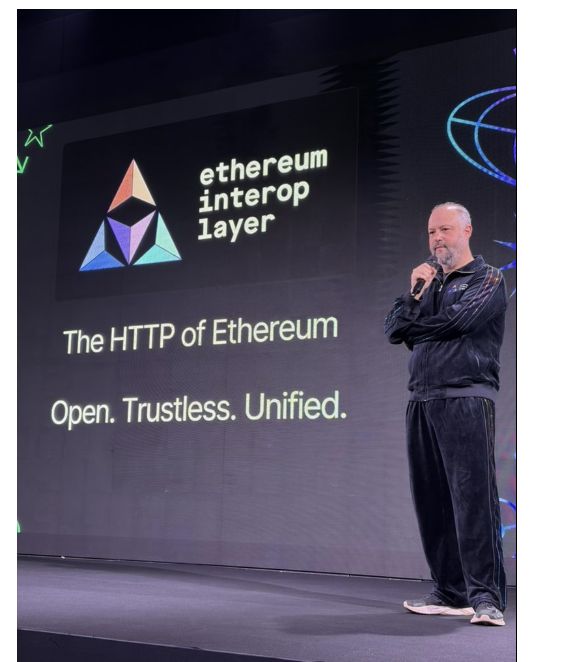Ethereum interoperability solutions: Simplifying complexity and reshaping the path of cross-chain collaboration
Author: Techub Hotspot Express
Author: Glendon, Techub News
Original Title: Ethereum "Interop Layer" Solution: From the Chain Management "Maze" to the "Broad Road" of the Network Era
Ethereum is building a highly unified and collaborative chain ecosystem.
Last night, the Ethereum Foundation's official blog revealed that the Ethereum Accounts and Chain Abstraction team has proposed the "Ethereum Interop Layer (EIL)" solution, aiming to merge all Layer 2 (L2) networks into a single, unified Ethereum chain at the user perception level. This would make cross-L2 transactions as seamless as single-chain transactions, while retaining the foundations of minimal trust and decentralization.
The concept of this interop layer was first proposed at the end of August this year and is currently in the testing and development stage.

Previously, Ethereum achieved large-scale expansion through Rollup technology, significantly reducing transaction costs and providing ample block space. This marks the gradual realization of its vision as a global computing platform. However, the development of technology often has two sides, and this evolution has also brought unexpected side effects, the most prominent being the fragmentation of user experience.
The Prosperity and Dilemma of L2
The current L2 ecosystem presents a rather complex situation, like scattered islands, with each chain having its own independent gas model, cross-chain bridge system, and even wallet system. When users transfer assets between networks such as Arbitrum, Base, and Scroll, they must manually select the chain, confirm the cross-chain path, and trust third-party liquidity providers. This operational complexity undoubtedly runs counter to Ethereum's original promise of a "seamless, trustless" experience.
From a user experience perspective, the consequences of this fragmented experience are quite severe. Ethereum's originally smooth experience advantage has been severely weakened, replaced by the complex operations brought by multiple independent "mini-Ethereums." Users no longer manage simple and direct transactions, but face a pile of L2s. This not only brings operational friction and cognitive burden but also introduces additional trust assumption risks, such as reliance on bridges, relayers, sequencers, etc., and invisibly increases censorship risk.
Although before the Ethereum Interop Layer (EIL) proposal, there were already some industry solutions attempting to unify the L2 user experience, unfortunately, most of these solutions deviated from Ethereum's core values. For example, some solutions introduce intermediary institutions for transactions, weakening censorship resistance; others entrust funds to third parties, greatly reducing security, and logic running on third-party servers also undermines transparency and the open-source spirit. Therefore, the accumulation of these contradictions has given rise to a fundamental need: to rebuild a single-chain-like user experience while retaining the scale advantages of L2.
So, how does the Ethereum Interop Layer (EIL) resolve this contradiction?
The Philosophical Foundation of EIL: Trustless Interoperability Paradigm
The Ethereum Interop Layer (EIL) will become the key breakthrough to resolve this contradiction. Its core positioning is as a secure and efficient communication protocol, not a financial tool.
The design logic of EIL is to make Ethereum Rollup transactions as seamless as single-chain transactions, allowing users to complete cross-chain transactions with a single signature, without introducing new trust assumptions. Its design philosophy is rooted in two core principles: ERC-4337 account abstraction and the trustless declaration.
ERC-4337 account abstraction standardizes account logic, enabling EIL to allow users to initiate cross-chain operations directly from their wallets without relying on relayers or solvers.
The specific operating principle is: in EIL, users use ERC-4337 accounts, whose logic is optimized for multi-chain usage scenarios. The wallet generates multiple different UserOps, then authorizes a single signature for the Merkle root of all these UserOps. Each on-chain account's verification part requires (i) a UserOp, (ii) a Merkle branch proving it belongs to a certain Merkle tree, and (iii) a signature for the Merkle tree root.
The main advantage of this approach is that it supports hardware wallets, which typically do not support generating N signatures simultaneously (the wallet only requires a single click from the user to complete the signature).

On this basis, EIL's design strictly follows the trustless declaration. EIL integrates key logic on-chain and into the user's wallet, ensuring all operations are executed in a verifiable on-chain environment. For example, when a user mints a cross-chain NFT, the wallet automatically merges multi-chain balances and transparently handles gas fees, without entrusting funds to liquidity providers.
This design fully safeguards Ethereum's four core values: self-custody (users have full control of assets), censorship resistance (no intermediary or centralized node can block transactions), privacy (smart contracts replace intermediaries, so there is no need to disclose the user's IP address or intent to relayers or solvers), and verifiability (all logic is open-source and auditable).
As emphasized by the Ethereum Foundation, from a technical architecture perspective, EIL is equivalent to Ethereum's "HTTP protocol." Just as HTTP unified the server access experience of the early Internet, EIL's goal is to make wallets the universal gateway for users to enter the multi-chain ecosystem, ultimately realizing the vision of "multiple L2s, one Ethereum."

At the same time, for users, this is a revolution from "chain management" to "chain perception."
The implementation of EIL will completely change the way users interact with the multi-chain ecosystem, mainly reflected in three key aspects: cross-chain transfers, cross-chain minting, and cross-chain swaps. Users can operate with one click, without having to select cross-chain paths or pay extra fees as in the traditional model. The core of this experience lies in the "wallet as portal" design, with cross-chain complexity fully encapsulated.
Ultimately, the introduction of EIL will also trigger a cascading effect in the Ethereum ecosystem:
-
Evolution of wallets and DApps: Wallet providers no longer need to develop custom integrations for each new chain. EIL's standardized interface makes multi-chain support a default feature. Developers can focus on user experience innovation rather than redundant cross-chain infrastructure.
-
Rapid onboarding of Rollups: When new networks join the ecosystem, EIL's compatibility design allows them to seamlessly integrate into existing wallet systems, accelerating technological iteration and user growth.
-
Consolidation of trust models: EIL eliminates reliance on off-chain operators, upgrading cross-chain interoperability from the "centralized exchange model" to the "decentralized exchange model." User assets are always held by smart contracts, with no counterparty risk, further strengthening Ethereum's commitment as the "world computer."
It is worth mentioning that the emergence of EIL will have a huge impact on the existing market landscape, eliminating the need for intermediaries such as relayers and solvers. As users tend to choose wallet services, this will inevitably lead to a decline in projects that solve or relay L2 transactions, with their transaction volume potentially dropping by more than 80%, or even directly destroying the related field, forcing these intermediaries to quickly adapt and transform, or face extinction.
Overall, the significance of the Ethereum Interop Layer (EIL) concept goes far beyond the technical level. It is a return to Ethereum's original intention: a global, open, seamless, and trustless computing platform. When wallets become universal gateways and cross-chain operations are as simple as single-chain transactions, Ethereum's "network era" will truly arrive.
Disclaimer: The content of this article solely reflects the author's opinion and does not represent the platform in any capacity. This article is not intended to serve as a reference for making investment decisions.
You may also like
WLFI Faces Security Breach Leading to $22M Token Burn and Wallet Freezes

Samourai Wallet Co-Founder Sentenced to Four Years, Highlighting Legal Risks for Crypto Privacy Tools

Corporate Crypto-Treasury Firms Under Pressure as BlackRock Pushes New Staked Ether Fund

Crypto and Tech Stocks Surge as Nvidia Shatters Earnings Expectations, Boosting Market Confidence

